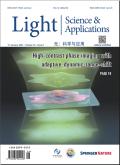Advancing inorganic electro-optical materials for 5 G communications: from fundamental mechanisms to future perspectives.
IF 23.4
Q1 OPTICS
引用次数: 0
Abstract
In the 5 G era, the demand for high-capacity and fast fiber-optic communication underscores the importance of inorganic optical materials with high electro-optical (EO) coefficients, rapid responses, and stability for efficient electro-optical modulators. The exploration of novel EO materials and their applications remains in the early stages. At present, research mainly focuses on the performance of EO materials and devices. However, the EO coefficients of different preparation methods for the same material and different materials vary significantly. Currently, a crucial gap lies in understanding the link between the EO effect and ferroelectric polarization, hindering advancements in ferroelectric material optimization. This article offers a comprehensive insight into the EO effect, initially discussing ferroelectric polarization and its relationship to the phenomenon. It then reviews standard inorganic ABO3 metal oxide ferroelectric ceramics and thin films, followed by an examination of emerging ferroelectrics such as HfO2-based polymorph ferroelectrics and ZnO/AlN-based materials. The article concludes by addressing the challenges in investigating ferroelectric EO mechanisms and provides an outlook on the future of EO material research, including a review of the latest developments in EO effect mechanisms and their optimization for light modulation, as well as an exploration of potential areas for high-performance EO materials research.推进5g通信用无机电光材料:从基本机制到未来展望。
在5g时代,对高容量和快速光纤通信的需求凸显了具有高电光系数、快速响应和稳定性的无机光材料对高效电光调制器的重要性。新型电致发光材料及其应用的探索仍处于早期阶段。目前,研究主要集中在EO材料和器件的性能上。然而,对于同一种材料和不同材料,不同制备方法的EO系数差异较大。目前,一个关键的空白在于理解EO效应和铁电极化之间的联系,阻碍了铁电材料优化的进展。本文从铁电极化及其与电磁效应的关系入手,对电磁效应进行了全面的研究。然后回顾了标准无机ABO3金属氧化物铁电陶瓷和薄膜,随后检查了新兴的铁电体,如hfo2基多晶铁电体和ZnO/ aln基材料。文章最后指出了研究铁电效应机制所面临的挑战,并展望了电效应材料研究的未来,包括对电效应机制及其光调制优化的最新进展的回顾,以及高性能电效应材料研究的潜在领域的探索。
本文章由计算机程序翻译,如有差异,请以英文原文为准。
求助全文
约1分钟内获得全文
求助全文
来源期刊

Light-Science & Applications
数理科学, 物理学I, 光学, 凝聚态物性 II :电子结构、电学、磁学和光学性质, 无机非金属材料, 无机非金属类光电信息与功能材料, 工程与材料, 信息科学, 光学和光电子学, 光学和光电子材料, 非线性光学与量子光学
自引率
0.00%
发文量
803
审稿时长
2.1 months
 求助内容:
求助内容: 应助结果提醒方式:
应助结果提醒方式:


